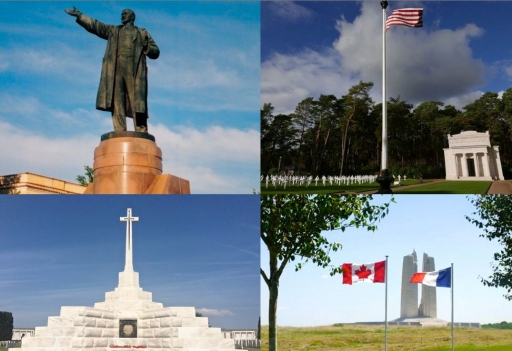Centenary News looks ahead to some of the major WW1 anniversaries which will be remembered in 2017.
After the big battles of 1916, the penultimate year of the Great War unleashed events that would reshape the world in the 20th century.
The United States, angered by Germany’s resumption of unrestricted submarine warfare, entered the war on the Allied side, sending its first troops to Europe.
Russia, engulfed by revolution, pulled out of the conflict. Its new Bolshevik leaders would, in time, transform the former tsarist empire into the communist Soviet Union.
Germany itself was increasingly squeezed by the British naval blockade, while the UK responded to the U-boat threat with the introduction of convoys to protect merchant shipping.
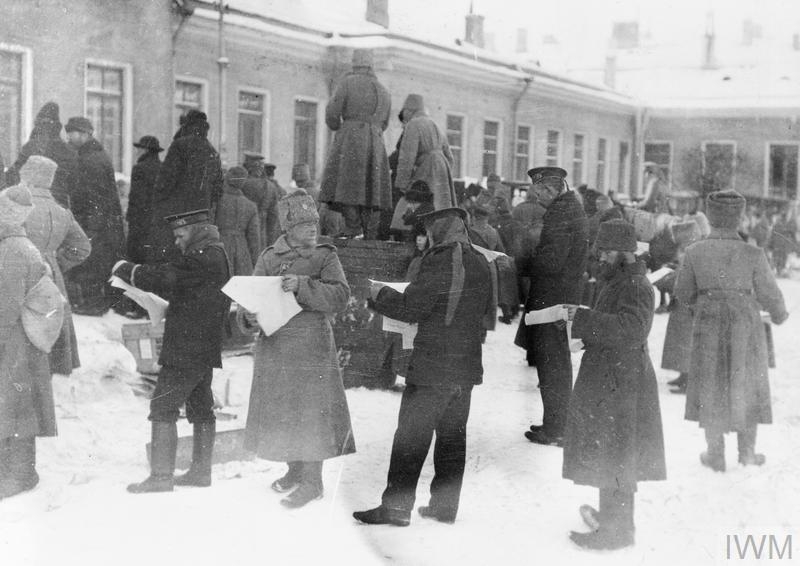
Military personnel and civilians reading news-sheets issued by the Duma, Russia’s Parliament, after Tsar Nicholas II’s abdication in March 1917 (Photo © IWM Q 69405)
In the Middle East, the Ottoman Empire came under growing pressure, losing both Baghdad and Jerusalem to British-led forces.
Deadlock and massive losses continued on the Western Front, albeit with some dramatic exceptions.
Canadian forces captured Vimy Ridge as part of Allied attacks in France in the spring.
But the French Army was severely shaken by the failure of General Robert Nivelle’s offensive on the Aisne. As mutinies broke out, Nivelle was replaced as commander-in-chief by General Philippe Pétain.
Britain embarked on one of its most controversial campaigns at the Third Battle of Ypres, also known as Passchendaele after the village which became its ultimate objective.
Italy, allied to Britain and France, suffered a disastrous defeat at the Battle of Caporetto. Austro-Hungarian troops, reinforced by German units, advanced more than 80 miles (130 kms).
Two institutions at the centre of the 2014-2018 Centenary programme – the Commonwealth War Graves Commission and the Imperial War Museum – were founded in 1917.
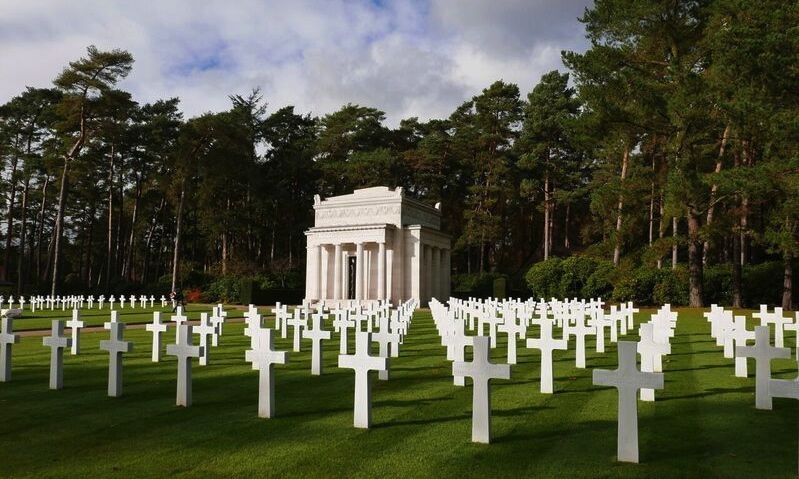 Brookwood American Cemetery and Memorial, near Woking in the UK. More than 400 US military dead of the First World War lie here (Photo: Centenary News)
Brookwood American Cemetery and Memorial, near Woking in the UK. More than 400 US military dead of the First World War lie here (Photo: Centenary News)
Summary of 1917 anniversaries
January
Germany secretly proposes a military alliance with Mexico if America abandons neutrality. Decoded by the British, the Zimmermann telegram causes outrage when it’s released to the US press in March.
February 1
Germany, increasingly squeezed by the British naval blockade, resumes unrestricted submarine warfare, despite concerns that it’ll bring the US into the war.
February 23
British-led Indian forces recapture Kut-al-Amara in Iraq, taken by the Ottomans in 1916 after a four-month siege, as part of a march on Baghdad.
February-April
German troops pull back to new defensive positions in France, known as the Siegfried Stellung (or Hindenburg Line). The withdrawal shortens the front, easing the strain on manpower and resources.
March 11
Baghdad falls to the British commander in Mesopotamia, General Sir Frederick Stanley Maude.
March
Tsar Nicholas II of Russia is the first of Europe’s monarchs to be dethroned by the Great War. He abdicates as civil unrest takes hold during the February Revolution (old-style calendar). A provisional government is formed.
April 6
America declares war on Germany, after losses of more US merchant ships in U-boat attacks. General John Pershing is appointed Commander-in-Chief of the new American Expeditionary Force (AEF).
April 9
Start of the Battle of Arras, part of new Allied offensives in France aimed at breaking the deadlock on the Western Front. Canadian troops capture the high ground of Vimy Ridge during the opening phases.
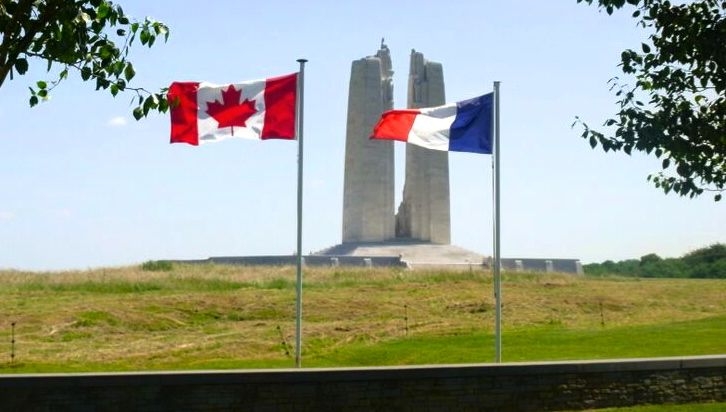
April/May
French hopes of a breakthrough with the Nivelle Offensive on the Aisne end in disaster. Amid mutinies, General Robert Nivelle is dismissed as Commander-in-Chief after only five months in charge. His successor is the defender of Verdun, General Philippe Pétain.
Also in May 1917, Britain introduces convoys to protect Atlantic merchant shipping from German submarines, after suffering potentially disastrous losses.
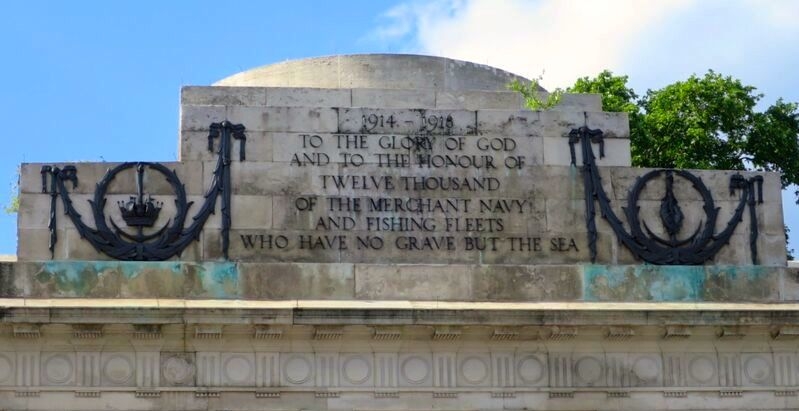 Inscription on the Merchant Navy Memorial, Tower Hill, London (Photo: Centenary News)
Inscription on the Merchant Navy Memorial, Tower Hill, London (Photo: Centenary News)
June 7-14
In a dramatic prelude to a new British offensive in Flanders, Messines Ridge is seized after hundreds of tonnes of explosives are detonated in 19 mines sunk beneath the German lines.
June 13
German ‘Gotha’ bomber planes carry out their first daylight raid on London – until now, the main threat has come from airships, most commonly Zeppelins.
June 25
First American troops arrive in France.
July 1
Russia launches the Kerensky Offensive, its last operation of the First World War. The attacks, ordered by Alexander Kerensky, War Minister in the provisional government, soon peter out against Austro-Hungarian and German forces on the Eastern Front.
July 6
Arab forces, aided by the British officer TE Lawrence (‘Lawrence of Arabia’), capture the Red Sea port of Aqaba from the Ottomans.
July 20
The Corfu Declaration is signed, paving the way for the creation of the Kingdom of Yugoslavia.
July 31-November 10
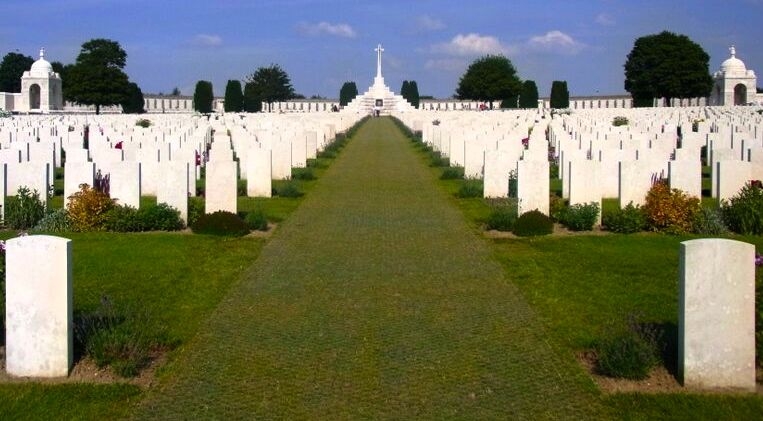
Tyne Cot Cemetery, the largest Commonwealth military cemetery in the world and last resting place for thousands of soldiers killed on the battlefields of Passchendaele and Langemarck (Photo: Centenary News)
Britain’s main Western Front offensive of 1917 starts at Ypres, with the aim of breaking out of the salient and recapturing naval bases used by the Germans on the occupied Belgian coast.
Field Marshal Sir Douglas Haig’s three month-campaign is notorious for being fought in appalling conditions, the battlefields of Flanders churned into thick mud by shellfire and torrential rain. The Third Battle of Ypres, also known as Passchendaele, ends in November with the capture of the village of Passchendaele by Canadian troops.
October 24-November 19
Italy suffers a rout at the Battle of Caporetto. Austro-Hungarian troops, reinforced by Germany, advance 130 kms as the Italians fall back to a new line on the Piave River.
October 31/November 7
The Ottomans are defeated in battles at Beersheeba and Gaza, clearing the way for British and Commonwealth forces to advance into Turkish-held Palestine.
November 2
Britain, having already backed the Arab Revolt against Turkish rule in 1916, now also expresses support for the ‘establishment in Palestine of a national home for the Jewish people.’ Foreign Secretary Arthur Balfour notes that the British Government ‘will use their best endeavours to facilitate the achievement of this object, it being clearly understood that nothing shall be done which may prejudice the civil and religious rights of existing non-Jewish communities in Palestine.’ His letter becomes known as the Balfour Declaration.
November 7
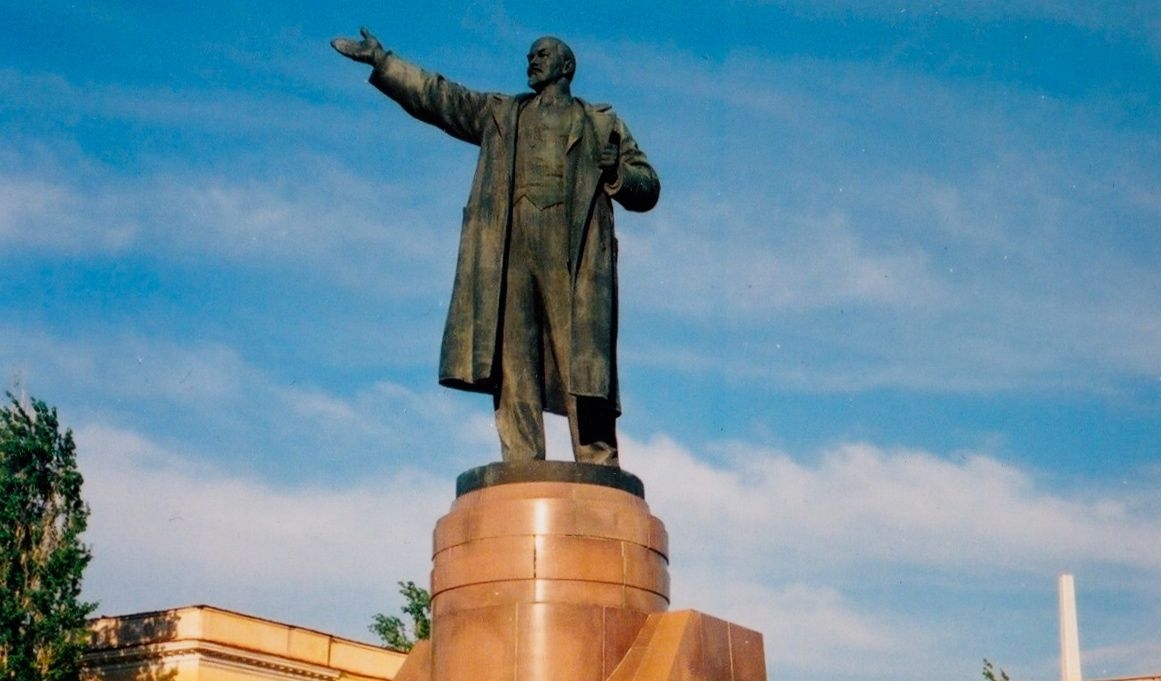 The Russian Revolution: The Bolsheviks, led by Vladimir Lenin (above) seize power, ousting the provisional government of Alexander Kerensky. They immediately call for peace talks. Germany facilitated Lenin’s return from exile in Western Europe after the February Revolution, hoping it would undermine the Russian war effort. The socialist revolutionary was allowed to cross German territory in a sealed train.
The Russian Revolution: The Bolsheviks, led by Vladimir Lenin (above) seize power, ousting the provisional government of Alexander Kerensky. They immediately call for peace talks. Germany facilitated Lenin’s return from exile in Western Europe after the February Revolution, hoping it would undermine the Russian war effort. The socialist revolutionary was allowed to cross German territory in a sealed train.
November 16
In the latest of a series of government reshuffles in France, Georges Clemenceau becomes Prime Minister. He will lead France through to the end of the war and the Versailles Peace Conference.
November 20
Tanks are used en masse for the first time in a British attack at the Battle of Cambrai in Northern France. Despite a significant breakthrough, they are held by German counter-attacks.
December
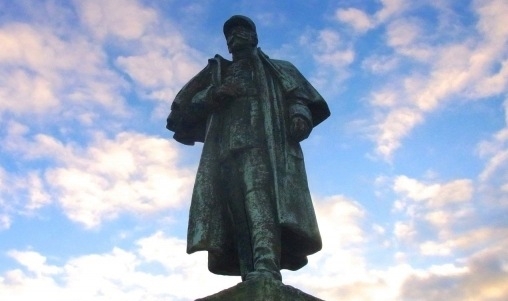
General Maurice Sarrail, dismissed as Allied Commander-in-Chief of the Salonika campaign in December 1917 (Photo: Centenary News)
December 11
After the fall of Jerusalem, the British commander, General Sir Edmund Allenby, enters the Holy City on foot.
December 15/16
Russia’s new revolutionary leaders sign an armistice with the Central Powers; peace talks will culminate in the territorial concessions of the Brest-Litovsk peace treaty in March 1918.
Centenary News will bring you updates on First World War Centenary events as 2017 progresses.
Sources: Wikipedia/Veterans Affairs Canada/Aisne 14-18/Passchendaele 2017/New Zealand WW100/various
Images courtesy of Imperial War Museums © IWM Q 69405 (Russia, March 1917); Centenary News
Compiled by CN Editor
